Red Banana is a category of Banana varieties with reddish-purple color. Some are smaller and thicker than the Yellow Banana, while others are significantly larger. The leaves of these plants are usually about 6 to 10 feet long. Flowers can appear on mature plants. Raw Red Bananas have cream to make light pink flesh when completely ripe. When compared to Yellow Bananas Red Bananas are softer and sweeter. Let’s check out a detailed guide to growing Red Banana in home garden below.
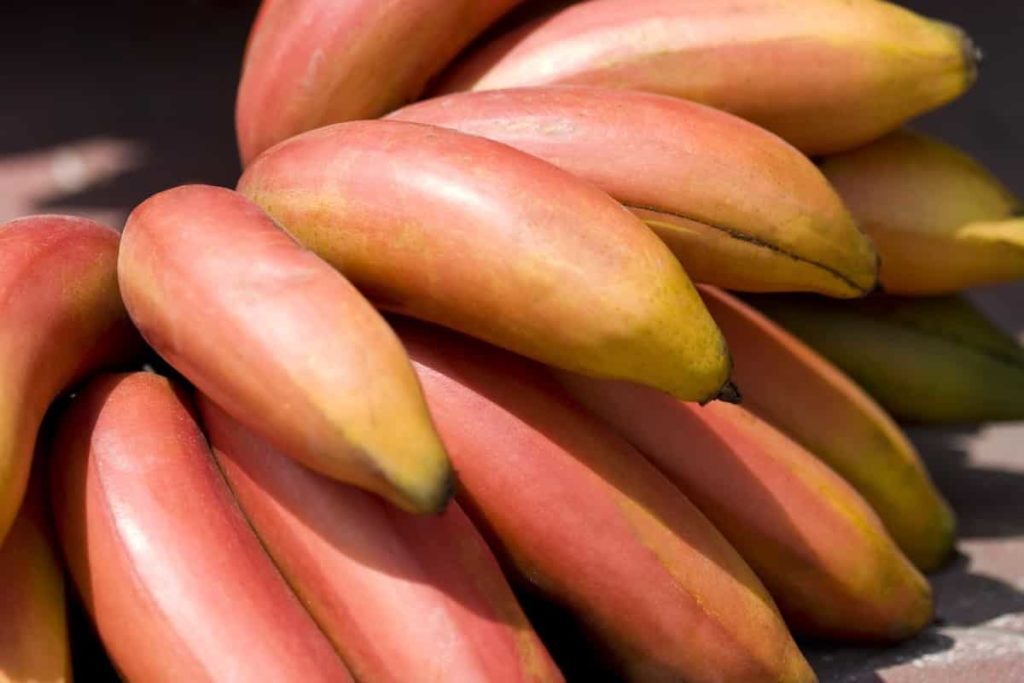
The Banana peel is thick, hard, and smooth, ripening from green to red-orange, bright red, dark red, yellow to maroon. Depending on the antioxidant content of the fruit the color of the peel will vary, and the peel can show some blemishes as it nicked and bumped in the harvest and shipping. As the fruit ripens the peel will produce several brown spots that are a sign of maturity. Once the peel is removed, it reveals a yellow-orange, ivory for light pink meat, leaving a fruity and sweet fragrance.
There are many varieties of Red Banana plants including Zebrina Banana, Siam Ruby Banana, and Bordelon Banana. Red Banana trees can include dwarf, medium, and tall plants. Every type is growing fast, and Banana plants are not hard to care for. This plant only needs occasional maintenance and very little pruning.
In case you miss this: Best Fertilizer for Banana Plants: Schedule, Organic, Natural, and NPK
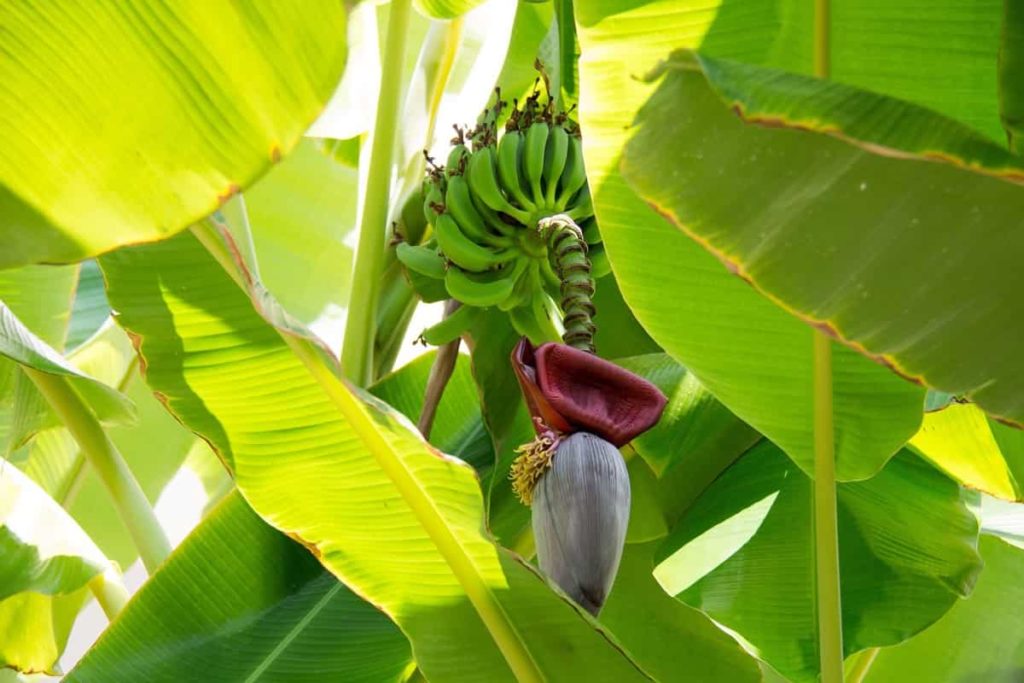
Guide to growing Red Banana in home garden
Climate requirement for growing Red Banana
Red Banana trees need full sun and a good tropical environment. Of course, all Banana plants need warmth to stay healthy. Cold temperatures can hinder or disrupt the Red Banana. Give Red Banana at least six to eight hours of sunlight. The more sunlight the plant gets, the brighter the colors of its leaves.
Banana trees require a sunny period of about 9 to 15 months. The first thing you should do is apply a new Banana plant between 20 to 30 days after last average frost date. The new plants should not be exposed to temperatures below 13°C, as it can delay their growth.
Soil and water requirements for growing Red Banana
Plant a Red Banana tree in proper soil. Red Bananas need light, well-drained soil. In terms of the soil itself, keep in mind that red Banana trees perform best in well-drained, slightly acidic soil. Soil with a pH between 5.5 and 6.5 is ideal. Modify your outdoor yard soil with compost or peat moss as needed. You should use three parts of a standard soil mixture and one part vermiculite or perlite if you are growing Red Banana in a pot.
The maintenance of the Red Banana tree is rather easy once you know that the tree is needed. First, the soil needs to be constantly moist, so make sure to water the tree well and do not let the soil dry. At the same time, be careful not to pour water on the ground, as this can result in root rot. You may need to irrigate during prolonged drought; however, Bananas are often resilient.
In case you miss this: Banana Planting Questions and Answers – (FAQs)
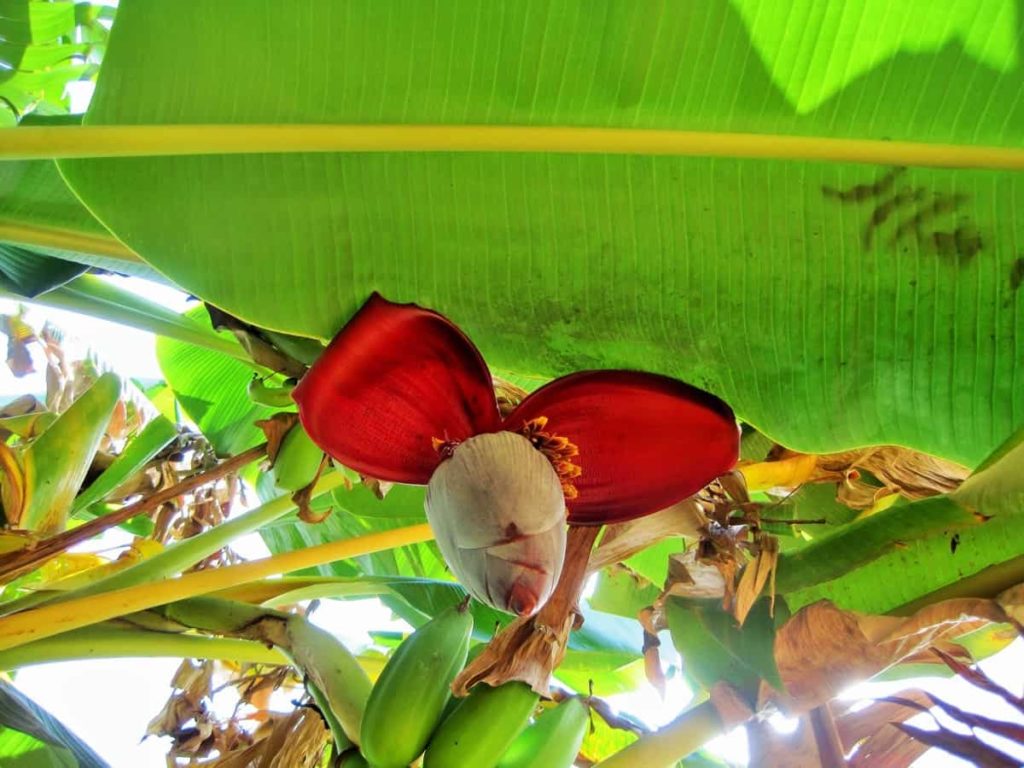
The Red Banana plant needs more water in summer. This is very important when after planting. Well-established Red Banana trees also won’t look their best without proper water. Newly planted Red Banana plants need adequate amounts of water as they cannot survive drought-like mature plants. You should water the Red Banana trees deeply and slowly until the surrounding soil is quite wet.
How to plant Red Banana in the home garden
Red Banana is a good choice for the garden, but it’s also a good choice to plant in outdoor pots and containers. Its large size and straightforward habit of growth lend it to using it as a solitary accent, or in a composition surrounded by small plants around the base and plants spreading on the edges. It is also big enough to be grown alone in a suitable container. Note that when plants grow in outdoor containers and baskets, they may need water more often than in the garden. If grown as an intercrop in coconut, the ground need not be plowed.
Pits should be taken while in a single-crop system the ground should be plowed well without clods, and pits of 1 and 1/2 feet deep and 8 feet distance should be taken and allowed to remain dry for 3 days. The Red Banana will be about 20 feet long at maturity, with a spread of 8 feet. It has a low canopy with a specific clearance of 1 foot from the ground. If you want to grow new Red Banana trees, propagate a Red Banana tree.
In case you miss this: Growing Red Campion – A Full Planting Guide
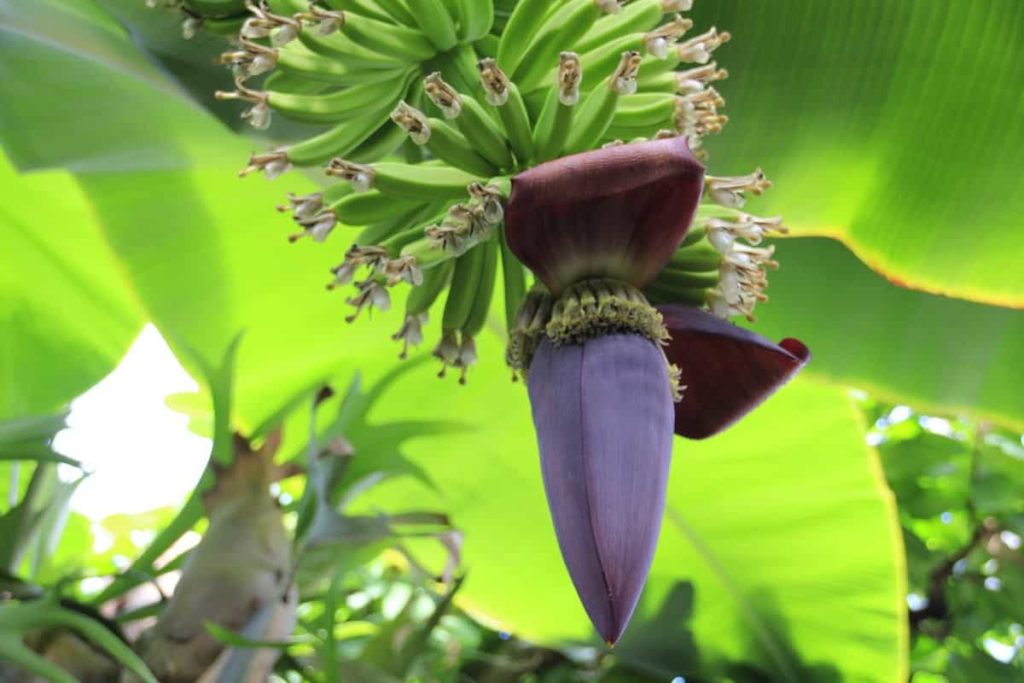
Every year the Banana tree will sprout new Rhizomes or stem nodes with its roots away from the edge of the main tree. Cut these rhizomes with spades and plant them in a new location to start more Red Banana trees. Individual shoots rise from underground Rhizomes and mature in one to two years, then eventually die after producing fruit, replaced by new shoots from the base.
However, given their final size and thickness, they almost behave as small trees in the landscape. This plant performs well in both full sunshine and full shade. It does best for equally moist conditions on average, but standing water will not tolerate it.
Fertilizer requirement for growing Red Banana
When it comes to the maintenance of a Red Banana plant, fertilize regularly (about every month) with potassium-rich elements, and even consider adding fertilizer and fertilizer to help boost its nutrients for effective growth. Red Banana trees are large eaters and need a lot of nutrients, especially for flowering and fruit production. Potassium-rich fertilizer is very good, and you may also consider adding compost and fertilizer to help increase the plant nutrient content.
It is recommended that you use up to 460 grams of fertilizer for a small plant and 1 kg for a mature plant. Another thing to consider is adding mulch, which returns nutrients to the soil after the plant is trimmed. Bananas are nutrient-loving plants that work best with constant applications of fertilizer. During the growing season, feed the plant generously with a balanced fertilizer about once a month. Do not get fertilizer on the trunk, as it can lead to disease. Follow the manufacturer’s instructions before feeding to prevent the burning of roots and water.
In case you miss this: Banana Growing Tips, Techniques, Ideas, and Secrets
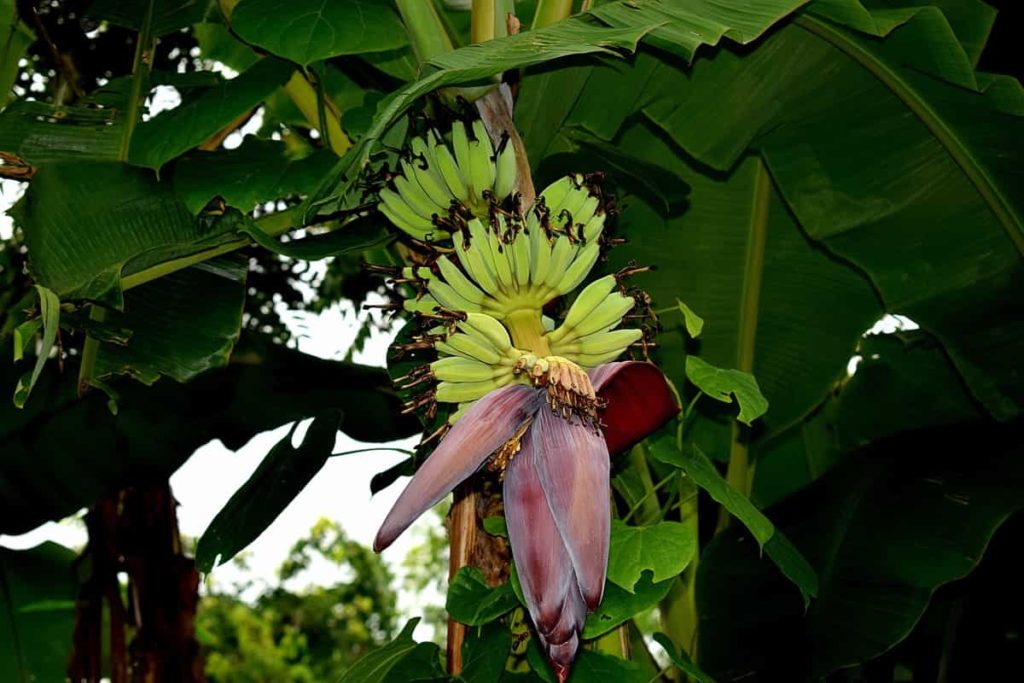
Pests and diseases of Red Banana
You can simply remove the dead leaves if you see any pests on them. when you see Keep in mind that plants can suffer from winter rot if kept too wet during their passive period, so be careful not to overwater your Red Banana plant. Bananas are generally durable and free from pests and diseases when grown in a temperate garden. Bananas are susceptible to common garden insects such as gophers, earthworms, and snails. Root rot can be lethal, especially in the cold end of the tree range, so be careful not to leave it standing in the water.
Scale insects can attack branches, cause ugly, rough formations. It can usually be treated with regular applications of horticultural oil. Red Banana tree leaves show symptoms like turning yellow and dying which means the tree is not getting the nutrients it needs. Inadequate fertilization, poor drainage soil, high water, and fungal infections are some of the common reasons for Banana trees.
When and how to harvest Red Banana
Red Banana trees bloom in the 7th month. All side suckers should be removed/destroyed till then. While Banana trees don’t need to be trimmed much, cutting old, dead leaves helps stimulate growth. Removing the leaves rub against the Banana bunch helps in fruit production. It improves the growth of the mother plant. If a ratoon crop is planned, keep a healthy sucker after removing the flower mother plant.
In case you miss this: Banana Peels In Garden – Compost Process, Fertilizer
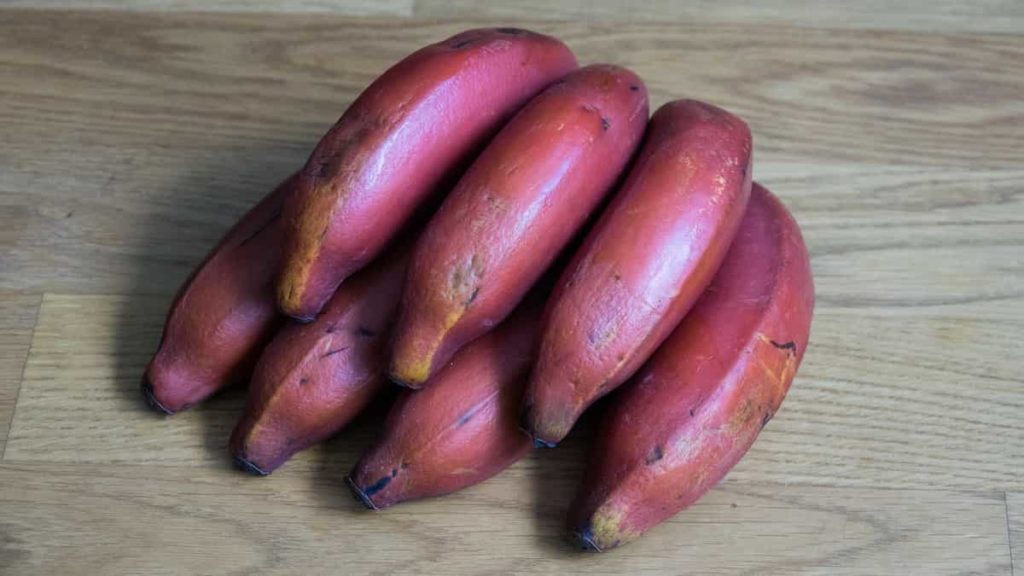
You can spray Panchakavya on flowers for good and high yield. When two empty bunches appear, flowers can be removed. 10 days after the bunch establishment, there should be a bunch covered with coconut fronds or dried Banana leaves, it does not cause much temperature injury and improves the color of the fruit. Harvesting can be done in the 11th to 12th months.
The mother’s plant should be cut down after harvesting as the plant can never be produced again. It is advisable to place the cut bunch in a well-padded basket before being taken to the collection site as Bananas are easily bruised and this will inevitably reduce the quality of the fruit. Once harvested, the bunch should be kept out of the light, in a cool and shady place.
- Growing Gold: Essential Techniques for Planting Pineapples
- How to Make Kalanchoe Plant Bushy: Home Remedies and Solutions
- 11 Reasons Why Your Gardenia is Not Blooming: Home Remedies and Solutions
- Eco Elegance: The Guide to Designing a Drought-Tolerant Landscape
- Gardening on a Slope: Strategies for Hillside Landscaping
- Nourish and Flourish: Top Organic Mulches for Thriving House Plants
- Everything You Want to Know about Indian Mogra Flower: Discover Uses and Growing
- Green Thumb Success: Expert Tips for Cultivating Greenhouse Pumpkins All Year Round
- Maximize Growth & Flavor: The Ultimate Guide to Companion Planting in Herb Gardens
- How to Control Rhododendron Problems Naturally: Home Remedies and Organic Ways to Fix Them
- Natural Magic: The Remarkable Benefits of Cinnamon for Plants
- Best Steps to Revive Dying Tulip with Natural and Organic Treatment
- 10 Reasons Why Your Angel Trumpet is Not Blooming: Remedies and Treatment
- How to Fix Periwinkle Leaf and Flower-Related Problems: Natural Remedies and Solutions
- How to Fix Zinnias Leaf and Flower Problems: Discover Natural and Home Remedies
- Organic Steps to Induce Lemon Tree Flowers: A Comprehensive Guide
- Bloom Booster: Crafting the Perfect Homemade Bougainvillea Fertilizer
- Optimizing Growth: A Guide to Applying NPK Fertilizer for Potted Plants
- 10 Best Homemade Fertilizers for Rubber Plant: DIY Recipes and Application Method
- How to Boost Female Pumpkin Flowers: Effective Steps for More Flowers and High Yields
- Transform Your Indoor Garden: Top Benefits of Pink Salt for Houseplants
- 10 Best Homemade Fertilizers for Peacock Plants (Calathea): Easy DIY Guide
- Unlock Blooms: 9 Reasons Why Your Potted Chrysanthemum is Not Blooming
- 8 Reasons Why Your Potted Hibiscus is Not Blooming: Fix it with Simple Solutions
- Unlock Blooms: 9 Key Reasons Your Potted Frangipani Won’t Flower
- 10 Reasons Why Is My Ice Plant Not Blooming: Remedies and Treatment
- 10 Reasons Why My Potted Hydrangea Not Blooming: Treatment and Remedies
- 10 Reasons Why is My Wisteria Not Blooming: Remedies and Treatment
- 10 Reasons Why is My Goldfish Plant Not Blooming: Remedies and Treatment
- Maximize Your Space: Ultimate Guide to Balcony Gardening with Grow Bags
- 10 Reasons Why Your Iris is Not Blooming: Remedies and Treatment
- 10 Reasons Why Your Anthurium Plant is Not Blooming: Treatment and Remedies
- 10 Reasons Why Your Aquaponic Plants Are Not Flowering: Remedies and Treatment
- 10 Reasons Why Your Agapanthus is Not Flowering: Remedies and Treatment
- Ultimate Guide to Brown Turkey Fig: Steps to Growing Brown Turkey Figs
- How to Grow Acai Berry: Propagation, Planting, and Care